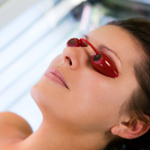Banning Indoor Tanning for Teens?
I’ve read that California has passed a law banning indoor tanning for teenagers even if they have their parents’ permission. Isn’t this going too far? Is indoor tanning really so dangerous?
Andrew Weil, M.D. | December 19, 2011

Originally posted, May 2010. Updated November 2011
Yes, indoor tanning really is dangerous, which is the point of the new California law, the strictest in the United States so far. (Other states are considering similar legislation.) The California law, which takes effect in January 2012, was passed because of accumulating evidence that use of tanning beds has led to an increased rate of melanoma, a potentially deadly type of skin cancer. Here are a few sobering statistics:
- Results of a study published June 2010 in Cancer Epidemiology, Biomarkers & Prevention showed that individuals who tanned indoors had a 74 percent increased risk of melanoma. If the radiation emitted was primarily ultraviolet A (UVA), the risk was 4.4 times normal.
- An analysis of 19 studies published in the June 1, 2007 issue of the International Journal of Cancer concluded that the risk of melanoma rises by 75 percent when use of tanning devices starts before 30 years of age. (PD- source 7 says before age 35. GN)
- In addition to the increased melanoma risk, people who use tanning beds are at higher risk of other types of skin cancer; they’re 2.5 times more likely to develop squamous cell carcinoma and 1.5 times more likely to develop basal cell carcinoma.
- A study from the World Health Organization found that a single use of a tanning bed boosts the risk of melanoma by 15 percent.
- A study published in 2011 in the journal Addiction Biology suggests that frequent tanning causes changes in brain activity in ways similar to those seen with drug addiction.
- According to the Skin Cancer Foundation, on an average day, more than one million people in the United States use tanning salons. Of these, 71 percent are girls and women aged 16-29. In this age group, melanoma is the second most common form of cancer, and women under the age of 39 are twice as likely to develop it as men.
- The International Agency for Research on Cancer (IARC), an arm of the World Health Organization (WHO), has added tanning beds to its "Group One" list of dangerous carcinogens for humans. The Skin Cancer Foundation noted that this designation was based on "consistent evidence linking UV radiation from indoor tanning devices to all major forms of skin cancer, including melanomas of both the skin and eyes."
You may ALSO be interested in findings from a study published in the September 2009 issue of the Archives of Dermatology: researchers recruited and trained college students to pose as 15-year-old, fair skinned girls in telephone calls to more than 3,600 tanning facilities nationwide. The students asked about the facilities’ practices and found that about 75 percent said they would allow a teenager to tan every day the first week and promoted "unlimited tanning" discount packages. In states with "youth access" laws, the facilities largely required parental presence or parental consent, but the laws didn’t limit how frequently a teen could tan.
I’m all for spending some time in the sun – but exposure should be linked to your need for vitamin D rather than for bronze skin. Learn more about appropriate sun exposure and check your state’s law on teen tanning.
Andrew Weil, M.D.









